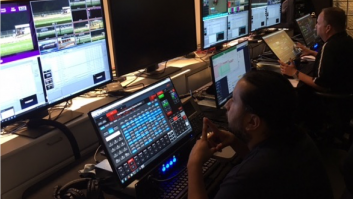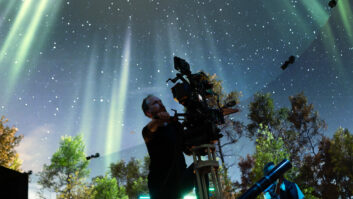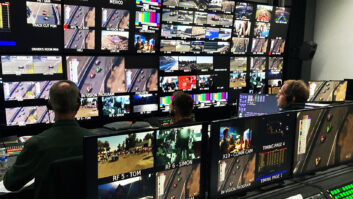As the New Year celebrations around the world fade into the distance, the media technology industry’s thoughts turn to what lies ahead in 2023.
TVBEurope invited a number of technology vendors to share their thoughts on what the future holds across a series of topics, including production, streaming, the metaverse, cloud and audio.
We’ll be publishing the responses across a series of features over the next few days. Today, we start with a look at production – from live to virtual and remote.
LIVE PRODUCTION
Bryce Button, director of product marketing, AJA Video
As live events returned in 2022, we saw a renewed appreciation for the experiences they offer, and this enthusiasm shows no signs of slowing in 2023. Not all audiences can attend every event in person, however, so live, low-latency video delivery from the venue to online and mobile platforms remains essential to reaching a wider audience. These developments are challenging content providers to constantly uplevel the quality of media experiences in-venue and across digital platforms. To this end, meeting audience expectations in the new year will require real-time workflows that support in-line image processing and transforms in the case of HDR/SDR interactions. From production through to post and online delivery, audio and video transport mechanisms will be paramount, whether using standard baseband, fiber, the ever-expanding universe of IP protocols (NDI, SMPTE ST 2110, Dante, etc.) or streaming codecs (H.264, HEVC, JPEG 2000 etc.)
This year, cloud-based tools enabled live production teams to further unlock new layers of metadata to provide audiences with an expansive palette of real-time data and analytics that enhance the viewer experience. We only expect the appetite for these applications to grow in the coming year, alongside the adoption of virtual production techniques that leverage game engines to create virtual sets, augmented reality graphics, and more. On the backend, we also anticipate many production crews, trucks, and facilities that have not already migrated from 3G-SDI to 12G-SDI will do so to gain single cable simplicity for 4K UltraHD production. If our experience is anything to go by, we’ll also likely see the continued evolution of remote production workflows and increasing investments in fiber transport mechanisms and affordable IP connectivity further spread across facilities, stadiums, and other live production venues.
Erling Hedkvist, sales and business development manager – arkona technologies
For live production we believe in the creation of private cloud facilities that are able to offer production services for true Tier-1 events. This is something that public cloud still is not capable of providing. Private and hybrid cloud centralised production environments are able to provide many of the same benefits of flexibility, redundancy and lower cost while providing the performance required for high-end productions.
Rafael Fonseca, VP of product management, Artel Video Systems
The flurry of work on standards that paved the way for the industry’s migration to IP is somewhat behind us. Though many of those standards continue to be refined and optimised, as well as used as building blocks for other technical recommendations reflecting applications and use, like ground-to-cloud-cloud to ground and ST2110 extending beyond the LAN to the WAN, among others. Early IP-centred projects generally were undertaken by larger companies either to address the requirements of special events, or because they were growing out of existing facilities and needed to invest in future-proof infrastructure and workflows.
In 2023 IP adoption will continue to become mainstream, implemented not only in greenfield applications, but also to augment or expand existing facilities. This will lead broadcasters and the industry to normalise and realise that it is a business after all, where pragmatism in implementation, fiscal prudency, and return on investment. This means that infrastructure and implementation choices will be done based on business levers where technology is just an enabler to accomplishing business imperatives. For example, in fibre-rich environments, fibre optics will be the choice over IP, where needed and possible on-prem production will be the choice over remote production, and compressed video would be the choice over uncompressed. With all the proven options available to broadcasters, choice is the biggest trend in 2023.
Chris Blandy, global leader, strategy and business development for M&E, AWS
More broadcasters are shifting acquisition, creation, processing, and distribution operations from ground to cloud, generating time and resource savings across the media supply chain. We expect this trend to continue in 2023. For example, FOX, Paramount, and Discovery are pioneering the future of video delivery using cloud-based services and solutions to run low-latency broadcast workloads with greater agility, elasticity, scalability, and reliability. Riot Games is also leveraging cloud infrastructure to combine advanced compression formats and ultra-low latency to maintain speed and quality of the data shared between the feed on-site at esports events and the teams at their new Project Stryker remote broadcasting centres. Continued advancements in the space are only poised to further streamline live production and distribution workflows in the year ahead.

Ram Sarup, product marketing specialist, Canon EMEA
As live events such as sports competitions, festivals, and tradeshows have resumed post-pandemic, it has become clear that remote production was not just a temporary fix, but something which broadcasters will continue to leverage for the foreseeable future. New IP and cloud-based technologies have enabled crews to work collaboratively and efficiently across live productions while physically apart – combining live feeds from cameras, overlaying shots with live graphics and even adding VoD (virtual on demand) assets from the ground. These technologies that are becoming increasingly more accessible enable live production teams to create complex, high-quality content across a variety of sectors that would have previously been beyond the scope of many budgets.
Over the next few years, auto-tracking systems that automate multiple camera positions without interference will continue to develop for virtually seamless live production collaboration, which is especially useful for fast-moving subjects like those found in live sports broadcasting.
Jane Sung, COO, Cinedeck
In 2023, we expect to see an increase in live production teams moving to virtualized and cloud-based workflows. By their nature, live production workflows benefit from flexibility and the option to scale. The ability to record to the cloud is transforming live media production, as it allows workflows to be managed remotely with just cameras and an encoder on site. This reduces logistical complexities and uses less of a team’s resources, because equipment and people don’t need to be transported to site.
Capturing footage direct to the cloud, streamlines production processes and provides more responsive editing of highlights and clips. It offers the ability to create clips on demand without dropping a single frame. As live production happens only once, it is important to leverage a multicam approach to deliver an engaging experience for viewers. The option to manage encoding and schedule ingest from multiple ISOs in the cloud provides more agility for fast-paced live production. The last few years have seen significant developments in both cloud-based live ingest and post-production services. Now that many teams have seen the benefits of a cloud-based approach first-hand, others are following in their footsteps and adoption will increase over the coming year.
Andrew Ward, head of business development, Cinegy
We see two things happening hand in hand as we look forward: more video via IP together with more virtual broadcast architecture. Video via IP has been transformed via the introduction of SRT and that in turn has been fueling the irresistible rise of virtualisation and cloud technology. SRT and cloud technology make it possible to deliver entertainment to consumers at full broadcast quality using the same endpoints without the compromises of old-style web streaming.
Dr Ciro Noronha, CTO, Cobalt Digital
During the pandemic, a lot of live production went remote. Remote live production requires low latency and there is a fundamental tradeoff between latency, quality and bit rate. To get there, you either need to sacrifice quality or pump up the bit rate (and pay for that). The answer has been the use of JPEG-XS, and our crystal ball says that it is going to continue and grow in 2023. There are better alternatives to explore, such as Ultra-Low Latency HEVC, which can match JPEG-XS in terms of quality and latency at a fraction of the bit rate. We believe this is also going to grow in 2023.
Another trend we see, especially for high-end sports, is to produce locally on large trucks and OB vans. This has never gone away. The difference is that the new trucks are all based on SMPTE ST 2110 uncompressed video over IP. For larger trucks, this is the way to go, and 2023 will see a significant increase. Do your live production using ST 2110 signals over IP, then use a low-latency encoder to push it out. 2023 should see more native ST 2110 devices that do not need SDI signals. In summary: advanced compression for remote production, uncompressed video over IP for local production in studios and trucks.
Peter Abecassis, senior product marketing manager at Grass Valley
In 2023, we will continue to see live content producers innovating to create a deeper connection with their audiences while creating workflows that address global issues such as the skilled labor shortage and a drive toward more sustainable production practices. Deeper audience engagement requires personalised versions of live events as well as event-related secondary content for social media and OTT platforms. Media organisations will require tools that help them quickly repurpose content by changing the commentary, the graphics, or the ads. They will also look for ways to automate workflows that help them quickly turn out highlight reels or fan videos that are suitable for social media platforms. To address labour shortages and sustainability, these tools will need to allow simple, secure, low-latency remote production and collaboration so the workforce can be anywhere. As everyone streamlines their processes, live event producers will want to do more with less by virtualising as much of their equipment as they can to maximise its utilisation. A single platform for production and distribution that unites multiple vendors will help media organisations create more content, more efficiently.
Mark Horchler, marketing director, products and solutions, Haivision
These days, live production workflows are increasingly characterised by remote production and cloud-based models at least to some degree. The adoption of remote production (REMI) and decentralised collaboration will continue into 2023 in more large-scale ways, picking up momentum post-lockdown. Yes, remote live production promises valuable benefits – flexibility and cost reduction – but its adoption was crystallised when remote technology for live production still delivered on high-quality outputs, even when using new technologies like IP bonding and cloud services. As we enter 2023, we will see remote production operations closely mimic that of in-studio production, thanks to advancements in latency, synchronisation, and integration with auxiliary services. As a result, more broadcasters will transition to remote production models, especially as 5G adoption grows simultaneously.
Russell Johnson, director, Hitomi Broadcast
As the competition for audiences gets fiercer, sports broadcasters are likely to invest more in their ability to immerse viewers in the action, especially for high-profile events. They need to be able to create compelling experiences both in terms of the video and audio content provided. The coverage of the Olympics showed that there is a large appetite for this type of immersive content along with proving the feasibility of delivering it. We expect to see more broadcasters adding to the number of video cameras used around events to record the play from multiple angles along with more microphones placed to create richer surround sound recordings.
Roland Axelsson, co-founder and product manager, Intinor
The big change is in decentralised production. This was forced on us in 2020, and now broadcasters are finding ways to create dramatic efficiencies with it. In sport, it means that you no longer have to move all the production equipment, all the operators and all the commentators to the event, with all that implies in terms of cost, environmental impact, and inefficient utilisation.
Thanks to the ability to bond multiple internet connections to provide capacity and resilience, you can now transmit multiple cameras and microphones from the event to a production hub in high quality and with very low latency. Commentators and analysts can be in a convenient studio or even work from home.
Here in Sweden we have a strong freelance camera operator community, so we do not have to send crews across our large country: we can get good people near where the game is. That will be another benefit of the trusted internet and remote production: a transformation in the freelance operator market.
Ronen Artman, VP marketing, LiveU
Cost-efficiency may be the key priority going into 2023, but climate change is also top of the global agenda. Broadcasters and sports organisations are increasingly looking for ways to cut costs and reduce their carbon footprints using cloud-based production workflows. IP bonding technology and cloud-based solutions are inherently suited for sustainable live productions, enabling reduced carbon footprints compared to traditional outside broadcasts. Reliable high-quality live events can be produced from centralised studio control room instead of on-site production and/or satellite trucks. This reduces the number of people required to travel to the site and the size and weight of the video encoding equipment being shipped. Multi-camera events can be supported with reduced equipment. The remote production model also offers advantages related to staff welfare with significantly reduced travel needs.

Rick Young, SVP, head of global products, LTN
Demand for high value live content across multiple digital platforms will surge in 2023, fueled by an explosion of rights and licensing deals. As broadcasters and rightsholders look for ways to efficiently bring tailored live event coverage to diverse global audiences while maximising the value of their content assets, we’ll see media companies adopting automation-driven production solutions to enable seamless content versioning for live sports and events. Content versioning innovation is enabling media owners to efficiently centralise acquisition, customise, decorate, and distribute live sports content at scale internationally, enhancing ROI and audience reach across any platform, device, or geography.
The growing acceptance of cloud and remote production will also continue in 2023, as broadcasters pioneer new real-world use cases. Over the past couple of years, we’ve accelerated quickly out of the pandemic and moved past initial experimentation phases — companies are now harnessing centralised remote cloud-based production workflows every day for high-value live content creation.
Yossi Tarablus – associate vice president global marketing, Pixellot
Broadcasters are looking for high-quality, cost-effective methods for giving audiences the 24/7, immersive sports content they crave. AI and digitalisation, which grew in popularity during the pandemic, will increasingly shape the broadcast industry as well. AI-based remote sports production technology simplifies broadcast workflows and democratises the sports viewing experience. Automated shooting, production, and streaming reduces the overhead required to produce and deliver sports events, eliminating the need for onsite production staff, trucks and operations centers associated with traditional broadcast production.
Teams and leagues now have another avenue for reaching new fanbases and creating new sponsorship and ad revenue opportunities. Many amateur sports don’t always have the budget for top-tier production values and this technology allows traditionally underrepresented sports to raise their profile and grow their audiences beyond a local level, easily and affordably. The technology also enhances the fan experience. Combined with automated camera tracking technology, fans get expanded views of every in/out call, challenge and replay.
These systems allow a wider array of sports and leagues to produce more games affordably with a higher degree of production values and lower costs. Everybody wins.
James Eddershaw, managing director, Shotoku Ltd.
Live Production continues to be a huge segment of the broadcast industry. We see more use of PoV camera angles to get closer to the action and produce more interesting viewpoints while not compromising on image and motion quality. This requires full specification cameras and high-end lenses, but in a compact and affordable remote camera package. Remote production also continues to grow with fewer staff required to be on-site or located in obtrusive positions within the production, leading to the need to control more cameras.
Peter Wharton, chief strategy officer, TAG Video Systems
2023 will be the year we see live production in the cloud begin to become a true possibility for many organisations. We know we can make the technology work and manage latency, bandwidth, quality, and processing capabilities. We will see the emergence of cost-aware orchestration engines that finally leverage cloud economics for live production and link provisioning.
We’ll also see how IP and ST 2110 transform the REMI model. This will be a move from production models where the remote location is a production truck with fixed backhauls or REMI with many backhauls to a deployable remote data center connected with fat WAN connections to the home office data centre, transforming REMI and fixed backhauls into highly agile interconnects and dynamically distributed processing.
VIRTUAL PRODUCTION
Dave Gill, chief technology officer, AE Live
People are still eager to watch sports, and sports properties and rights-holders are fighting harder for those eyeballs which are getting harder to attract and retain. Audiences now expect a more immersive experience with online interactivity and a mix of graphics. Technology like Augmented Reality (AR) has emerged beyond being an upsell to becoming a core service. What was once nice-to-have is now a must-have.
Companies need to adapt their business models to account for this increased and changing demand.
The Virtual Studio trend is another add-on service/turned broadcast staple. Audiences may not know, or even care about, what they’re seeing but for broadcasters and federations, it definitely makes a difference – financially and aesthetically.
A virtual studio environment adds incredible editorial flexibility, expanding what’s possible for giving the viewer at home a brilliant experience. Once a producer sees the end result and the range of programming that comes with it, they understand the potential impact on the entire content ecosystem.

Christina Nowak, director of virtual production, Anna Valley
Virtual production is going through a process of rapid evolution as the industry starts to get to grips with this new approach to creating content. With the recent increase in VP studio availability, one of the things we expect to see in 2023 is more consideration for the overall infrastructure at virtual production locations – as opposed to just the technology provided. Virtual production teams are quickly learning that not all studios are created equal and how things like the total floorspace (and not only the size of the volume) can impact shot composition, how load-bearing capacities have to be taken into consideration for three-dimensional volumes and how even cabling and cooling systems can impact production schedules.
As more production professionals get first-hand experience with VP, we also expect workflows to mature, and we anticipate more time will be allocated to troubleshooting and testing in production schedules. For example: we expect to see a physical pre-vis becoming a standard part of pre-production, allowing teams to test their virtual designs in a physical LED environment and then go back into design to make adjustments before they conduct camera and lighting tests.
There’s no doubt that lighting for virtual production will become more photorealistic in 2023 thanks to new tech developments like Unreal Engine’s Lumen feature which automatically computes how light interacts with different objects, and Kino Flo’s Mimik VR which allows video content to be perfectly mirrored on a LED light.
Finally, we hope to see the empowerment of the virtual art department in 2023. If we can get to a point where the technologies and workflows used on a production are dictated ahead of time by the processing power needed to deliver the art department’s designs with the production schedule, then we’ll be one step closer to harnessing the creative potential of virtual production.
Richard Mead, CEO at Brompton Technology
With a strong foothold already established in TV studios and film sets around the world, virtual production is poised to move from early adoption to early majority, with production crews and digital storytellers taking full advantage of its flexibility and freedom.
2023 and beyond is looking brighter than ever for LED setups thanks to the on-going In-Camera Visual Effects (ICVFX) evolution and technology improvements. The importance of colour accuracy will become even more critical as studios look for ultra-realistic in-camera visuals where virtual and physical worlds seamlessly merge together, while new workflows and tools will keep improving producers’ experiences.
Pixel pitch will keep getting finer, increasing the pixel density of panels and their potential use for new markets. With new types of LEDs arriving, tools for control and simplification of workflows and correct calibrations will make content look better than ever, while giving increased flexibility to creatives.
Last but not least, with a large number of permanent xR and VP installations already implemented around the globe, bespoke/pop up LED stages could be the next big thing, with systems designed to meet the requirements of specific productions that could be easily rebuilt for the next project.
Overall, there are a lot of pixels on the horizon. Things just keep getting bigger and more advanced!
Kieran Philips, sales and marketing manager for CJP Broadcast Service Solutions Ltd
Virtual production offers a myriad of benefits for broadcasters and the film industry, offering creativity advantages whilst economising budgets and time. Its appeal is widening out to a wider market of content producers as cheaper solutions become more reliable and widely available. Here at CJP we expect to see a continuing growth in the level of investment in virtual production technology in 2023, most notably in the education sector, and it’s likely that we’ll see an increase in its usage across a wide range of academic departments. Certainly, we can already see the convergence of media and games design departments, and this eventually it’s likely to encourage collaboration with other departments across seemingly disparate disciplines such as health, sport, business, and the creative arts. Outside of academia, marketing, training, learning and development teams in corporates and enterprises are also likely to continue exploring the benefits that virtual production has to offer.
As far as the technology itself is concerned, there’s a trend towards the design of a more sustainable approach for LED virtual production such as panel selection by power reducing components like cathodes. Hybrid Green Screen & LED workflows will be further developed, working with near-time cloud rendering and the integration of cloud services.
It will be interesting to see, with the evolving technological and software changes, how Epic Games may change their entire business model as the market expands and if this presents an opening to Unity in 2023. Time will tell…
Stephen Gallagher, marketing director, Mo-Sys
As the economy continues to slow down and we inevitably head towards a recession, I see companies moving to make smarter investment choices with the demand for high quality content still increasing. Rather than splashing out on the huge LED volumes that have been popular previously, there’s likely to be a trend towards installing more modestly sized screens alongside green screens, drawing on the complementary advantages of both types of studio. This is going to appeal to a wide cross section of content creators from broadcast, film and corporates. Virtual Production is a great enabler. It can be utilised to deliver far away exotic locations and unreal scenes where budget constraints would have otherwise meant abandoning the project.
REMOTE PRODUCTION
David Hoffman, business development manager, Blackmagic Design, Americas
2022 saw significant uptake of technologies like remote and virtual production, but in 2023, we’ll start to deal with the unexpected consequences of the new workflows using this technology. More specifically, we’ll start to tackle the challenge of homogenisation. Many of the industry groups worldwide have been trying to work toward common standards, but given the enormously broad set of approaches (and groups) that we now have, we simply aren’t going to see a grand unifying theory of production.
What we are going to see are groups tackling this from a methodological point of view: how do we come up with best practices so that content and metadata are as useful to as many folks as possible so that everything is streamlined and efficient. That’s important, because some of these people will be in the studio or arena, and some will be in a cabin in the woods, or in a van. Remote production lets us put the best possible people on a job, wherever they are, but it also means that we have a responsibility to them, and in turn, will reap the benefits of making things as simple as possible.

Simon Browne, VP of product management, Clear-Com
The pandemic taught us that being remote and still contributing to production was more than just feasible, it now seems to have tailored production flow permanently. Teams assigned with varying slots within the series production can call upon the synchronous use of remote producers, remote editors, remote contributors, and camera teams in very regionally separated places. Cloud-based AV production and monitoring has helped make this possible. 2023 will elevate these technologies to allow the best-equipped teams to work cooperatively in real time despite not sharing the same physical space.
Rob Waters, global sales director at Dejero
With continued demand for live content, at a time when budgets remain tight and the environment is more in focus, remote productions will grow further and faster than ever in 2023.
Technological advances in 5G will allow higher quality content to be produced without the need for full onsite production but in rural and remote locations many of the existing issues will require different approaches.
Complete solutions offering temporary private networks, easily deployed, and supplied with a managed backhaul from location to control room will become more widely used enabling better value productions.
Stephen Tallamy, CTO, EditShare
Coming to maturity in 2023 is the idea of hybrid production workflows. Hybrid in the sense that it will be part on location, part remote; part using traditional tools onsite and part in the cloud.
If we take the example of a major sporting festival, like the recent FIFA World Cup. The core content comes from the host broadcast organisation, nowadays in multiple streams. Big broadcasters will have some facilities and talent on site, but the core of their production will be back at their home base. Content will reside in the cloud, accessible by all.
Central to this is cloud editing, which is a transformative technology. All your media is available in the cloud, along with all the metadata. By hosting your preferred editing software in your cloud too, you can access huge resources without the cost or time of moving it. If you have the right asset management and storage architecture, all you need is remote desktop/PC-over-IP software and a modest broadband connection.
VIDEO PRODUCTION
Graham Sharp, CEO, Broadcast Pix
It is clear we will continue to see an increase in the use of video in all walks of life, which will in turn drive an appreciation of ‘quality’ as content creators continue to try to differentiate themselves.
By trying to emulate the broadcast-quality content we see on our TVs each day, video producers everywhere are demanding professional-grade tools. So, we as an industry must continue to make these tools not only available but also easy to use for non-broadcast trained operators.
I believe the “next big thing” is the empowerment of content creators of all skill levels by making professional tools easy to use. Let’s focus on providing simpler and better ways to create and produce professional-looking programming – without expensive training and equipment. Equipment that is simple to install and easy to operate by anyone.
In 2023 and beyond, let’s refocus our attention on simplicity – let’s truly democratise video production.







